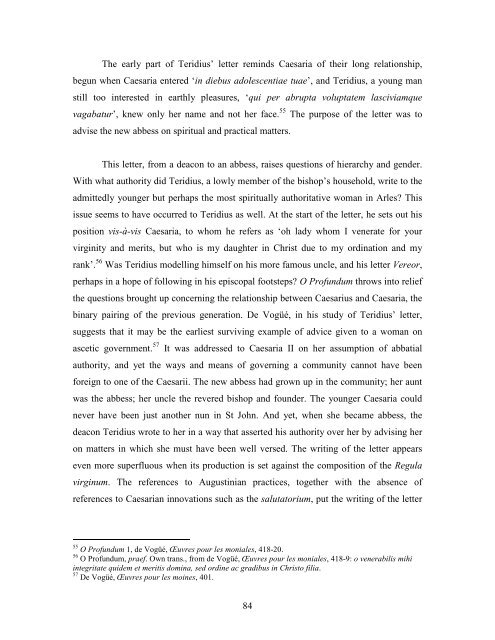Lindsay Rudge PhD Thesis - University of St Andrews
Lindsay Rudge PhD Thesis - University of St Andrews
Lindsay Rudge PhD Thesis - University of St Andrews
Create successful ePaper yourself
Turn your PDF publications into a flip-book with our unique Google optimized e-Paper software.
The early part <strong>of</strong> Teridius’ letter reminds Caesaria <strong>of</strong> their long relationship,<br />
begun when Caesaria entered ‘in diebus adolescentiae tuae’, and Teridius, a young man<br />
still too interested in earthly pleasures, ‘qui per abrupta voluptatem lasciviamque<br />
vagabatur’, knew only her name and not her face. 55 The purpose <strong>of</strong> the letter was to<br />
advise the new abbess on spiritual and practical matters.<br />
This letter, from a deacon to an abbess, raises questions <strong>of</strong> hierarchy and gender.<br />
With what authority did Teridius, a lowly member <strong>of</strong> the bishop’s household, write to the<br />
admittedly younger but perhaps the most spiritually authoritative woman in Arles? This<br />
issue seems to have occurred to Teridius as well. At the start <strong>of</strong> the letter, he sets out his<br />
position vis-à-vis Caesaria, to whom he refers as ‘oh lady whom I venerate for your<br />
virginity and merits, but who is my daughter in Christ due to my ordination and my<br />
rank’. 56 Was Teridius modelling himself on his more famous uncle, and his letter Vereor,<br />
perhaps in a hope <strong>of</strong> following in his episcopal footsteps? O Pr<strong>of</strong>undum throws into relief<br />
the questions brought up concerning the relationship between Caesarius and Caesaria, the<br />
binary pairing <strong>of</strong> the previous generation. De Vogüé, in his study <strong>of</strong> Teridius’ letter,<br />
suggests that it may be the earliest surviving example <strong>of</strong> advice given to a woman on<br />
ascetic government. 57 It was addressed to Caesaria II on her assumption <strong>of</strong> abbatial<br />
authority, and yet the ways and means <strong>of</strong> governing a community cannot have been<br />
foreign to one <strong>of</strong> the Caesarii. The new abbess had grown up in the community; her aunt<br />
was the abbess; her uncle the revered bishop and founder. The younger Caesaria could<br />
never have been just another nun in <strong>St</strong> John. And yet, when she became abbess, the<br />
deacon Teridius wrote to her in a way that asserted his authority over her by advising her<br />
on matters in which she must have been well versed. The writing <strong>of</strong> the letter appears<br />
even more superfluous when its production is set against the composition <strong>of</strong> the Regula<br />
virginum. The references to Augustinian practices, together with the absence <strong>of</strong><br />
references to Caesarian innovations such as the salutatorium, put the writing <strong>of</strong> the letter<br />
55 O Pr<strong>of</strong>undum 1, de Vogüé, Œuvres pour les moniales, 418-20.<br />
56 O Pr<strong>of</strong>undum, praef. Own trans., from de Vogüé, Œuvres pour les moniales, 418-9: o venerabilis mihi<br />
integritate quidem et meritis domina, sed ordine ac gradibus in Christo filia.<br />
57 De Vogüé, Œuvres pour les moines, 401.<br />
84

















